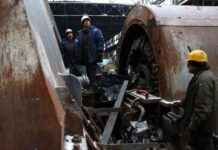“London Bridge is down.” With this sentence – in German something like “London Bridge has collapsed” – the Queen’s private secretary is supposed to inform the British Prime Minister in the event of the Queen’s death. According to the UK Foreign Press Association, a whole series of steps will then follow, codenamed Operation London Bridge.
The Foreign Office will relay the message to governments outside the UK, where the Queen is Head of State, and to the rest of the Commonwealth.
The day the Queen dies is called D-Day. Each subsequent day up to the day of the burial is referred to as D-Day 1, D-Day 2, and so on.
Ministers will be notified of the death by email. Within ten minutes of the death being announced, the flags are lowered to half-mast on Whitehall in the government district of London.
The British news agency Press Association will broadcast a flash report. At the same time, the official notice of death is pinned to the gate or to an easel at Buckingham Palace.
The British parliament and the parliaments of Scotland, Wales and Northern Ireland are adjourned.
A black page appears on the royal family’s website with a statement confirming the death. A black banner is displayed on the UK government website.
The Prime Minister will be the first to make a statement.
The royal family will release plans for the state funeral, which is expected to take place ten days after the death. A national minute of silence is announced.
The prime minister will hold an audience with the new king. In doing so, he initiates Operation Spring Tide.
Elizabeth II will be succeeded by her son Prince Charles. It is not yet clear what name he will take as king – it could be Charles III. or George VII. He was baptized Charles Philip Arthur George and could take any of those names.
The king will address the nation.
Parliament meets to pass a message of condolences. All parliamentary work is suspended for ten days.
The Prime Minister and Cabinet will meet the new King at 3.30pm.
If the Queen dies in Balmoral, Scotland, where she is, her body will be taken to London on the royal train (“Operation Unicorn”). If this is not possible, her body will be flown back to London.
England and the world are worried about Queen Elizabeth II. The 96-year-old had to cancel a virtual meeting of her privy council. Arndt Striegler from London explains why the Queen’s right hand has turned blue and how the monarch is currently doing.
He then embarks on a journey of mourning across the United Kingdom, beginning with Scotland. He will accept a message of condolence in the Scottish Parliament and attend a service at St Giles’ Cathedral in Edinburgh.
There is a rehearsal for Operation Lion: the procession carrying the coffin from Buckingham Palace to the Houses of Parliament the Palace of Westminster.
Rehearsal for the state funeral procession








